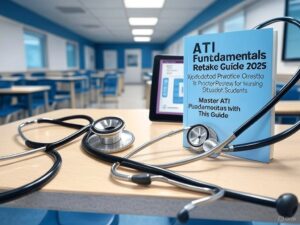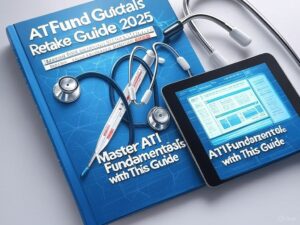-
Updated practice questions for the 2025 ATI Fundamentals exam
-
Comprehensive proctor review with performance-boosting strategies
-
Covers key fundamentals concepts for nursing students
-
Designed for students retaking the ATI Fundamentals exam
-
Helps build confidence and improve test scores
Preview
1. Temporal Artery Thermometer Use
Question:
A nurse is assessing the body temperature of an adult client using a temporal artery
thermometer. Which of the following actions should the nurse take? (Select all that
apply)
a. Slide the probe across the client’s forehead
b. Pull the client’s pinna up & back
c. Hold the client’s hair aside while performing the procedure
d. Document the client’s temperature with “AX” next to the value
e. Move the probe in a circular motion
Correct Answers: a, c
Rationales:
• a. Slide the probe across the client’s forehead: This is the correct
technique for using a temporal artery thermometer.
• b. Pull the client’s pinna up & back: This is appropriate for tympanic
temperature measurement, not temporal.
• c. Hold the client’s hair aside: Hair can interfere with the accuracy of the
reading.
• d. Document the temperature with “AX”: “AX” refers to axillary temperature,
not temporal.
• e. Move the probe in a circular motion: The probe should be slid in a
straight line across the forehead.
2. Dilating Vein for IV Insertion
Question:
A nurse is preparing to insert a peripheral IV catheter. Which action should the nurse
take to help dilate the vein?
a. Stroke the skin near the vein in an upward position
b. Dangle the client’s arm over the edge of the bed
c. Apply a cool compress to the vein for 10 min
d. Instruct the client to flex their arm with the hand open
Correct Answer: b
Rationale:
• b. Dangle the client’s arm: This promotes venous pooling, making the vein
easier to visualize and access.
• a. Stroke the skin upward: Not a standard method for vein dilation.
• c. Apply a cool compress: Cold causes vasoconstriction, not dilation.
• d. Flexing the arm: This can compress veins, making insertion more difficult.
3. Suctioning Tracheostomy
Question:
When suctioning a client’s tracheostomy, which action should the nurse plan to take?
a. Apply intermittent suction during insertion
b. Suction for 20 seconds per pass
c. Hyperoxygenate the client for 30–60 seconds before suctioning
d. Decrease suction pressure to 150 mm Hg if O₂ sat drops
Correct Answer: c
Rationale:
• c. Hyperoxygenate: Reduces hypoxia risk during suctioning.
• a. Intermittent suction during insertion: Suction is applied during
withdrawal only.
• b. 20 seconds: Suctioning should not exceed 10–15 seconds per pass.
• d. 150 mm Hg: Suction pressure should be 80–120 mm Hg for adults.












Reviews
There are no reviews yet.